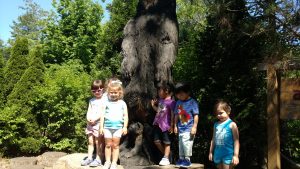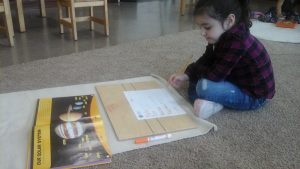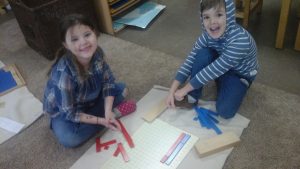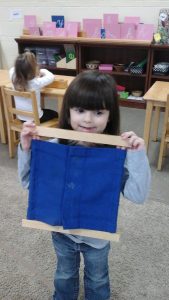Explosion of vinegar and baking soda
What will happen if we put vinegar and baking soda in a sandwich bag?
We put vinegar in a sandwich bag and added baking soda, and the zipped sandwich bag popped!
Mixing vinegar and baking soda causes the sodium bicarbonate (baking soda) to react with acetic acid (vinegar) releasing carbon dioxide gas and making sodium acetate. The CO2 gas production caused the ziploc bag to pop.
Fire Resistant Water Balloon
What will happen if we put a flame under a balloon? What will happen if we put a flame under a balloon filled with water compared with putting a flame under a balloon with no water? The balloon without water popped when a flame was placed under it. The balloon with water in it did not pop when a flame was placed under it.
The thin balloon allows the heat to pass through very quickly and warm the water. As the water closest to the flame heats up, it begins to rise and cooler water replaces it at the bottom of the balloon. This cooler water then soaks up more heat and the process repeats itself. In fact, the exchange of water happens so often that it keeps the balloon from ever popping! The carbon was deposited on the balloon by the flame, and the balloon remains undamaged.
Paper Towels vs. Diapers
-Absorption “ To take something in”

What will happen if we pour water in a container containing paper towels and another container containing Sodium Polyacrylate(the stuff in diapers)? Which will hold more water, paper towels or Sodium Polyacrylate?
The container with the paper towels absorbed some water but not all the water. Some of the water spilled out of the container. The container that had Sodium Polyacrylate absorbed all the water. None of the water spilled out of the container.
The Sodium Polyacrylate holds more water than paper towels and is therefore, more absorbent.
Magic Milk Rainbow
Surface Tension
“A property of a liquid keeping an object from going into the liquid”

What will happen if we put drops of food coloring on the top of milk in a bowl and place dish soap in the middle of the milk?
We placed the drops of food coloring(green, red, and yellow) on top of milk in a bowl and we put dish soap on the end of a Q-tip in the middle of the milk.
When we dipped the dish soap soaked Q-tip in the milk the food coloring swirled!
Food coloring is less dense than milk so it floats on the surface of the milk. When the dish soap touches the milk, the milk’s surface tension changes and the milk begins to move in an attempt to keep normal surface tension. This movement causes the food coloring to mix creating a milk rainbow.
Pop Rock Expander
-Chemical Reaction
What happens when we mix Pop Rock candy and soda? Should we ask Mikey?
First, get an entire package of Pop Rocks into a balloon using a funnel and place the balloon over the mouth of a bottle of soda. Grab the balloon and dump the Pop Rocks into the soda. And then the balloon was inflating!
Both candy and soda contain pressurized carbon dioxide gas. When the Pop Rocks are dropped into the soda, aome carbon dioxide is able to escape from the high fructose corn syrup of the soda and, because the carbon dioxide gas has nowhere to go in the bottle, it rises into the balloon.
Dancing Spaghetti
-Carbonation
What are the bubbles? What will happen when we put cooked spaghetti in a fresh glass of baking soda/vinegar mixture?
We made a “batch” of baking soda/vinegar mixture(2 cups of water and 2 cups of vinegar). We dropped several strands of cooked spaghetti into the baking soda/vinegar mixture, Add 1 tablespoon of baking soda to the water/vinegar mixture.
The spaghetti sinks to the bottom of the baking soda/vinegar mixture. Then when the baking soda is added bubbles are produced lifting the spaghetti throughout the liquid.
The carbonated bubbles rise to the top “pushing” the spaghetti towards the top of the bowl creating dancing spaghetti,
Tea Bag Hot air Balloon
What will happen when we set fire to an unused, empty tea bag?
First we cut the unused tea bag and discarded the tea leaves and then made the tea bag into a shape of a cylinder. Mr, John set fire to the tea bag, As the tea bag burned, it began to float up.
When the tea bag burns down it gets lighter in weight and the air around the flame gets hotter. Hot air rises and once the burnt tea bag is light enough it gets carried up with the hot air.
Suspension(chemistry)
-A state of matter “A fluid containing solid particles”
What will happen if we mix cornstarch and water?
We mixed cornstarch and water and slowly put our finger in the mixture. We quickly hit the mixture.
When we slowly put our finger in the mixture it went into the mix like a liquid. When we quickly hit the mixture our fingers stayed dry, out of the mix. It felt like a solid.
By mixing the cornstarch and water we created a state of matter known as suspension. When we hit the Cornstarch Suspension it felt like a solid because its molecules line up. But it looks like a liquid and acts like a liquid when no one is pressing on it because the molecules relax.

















































